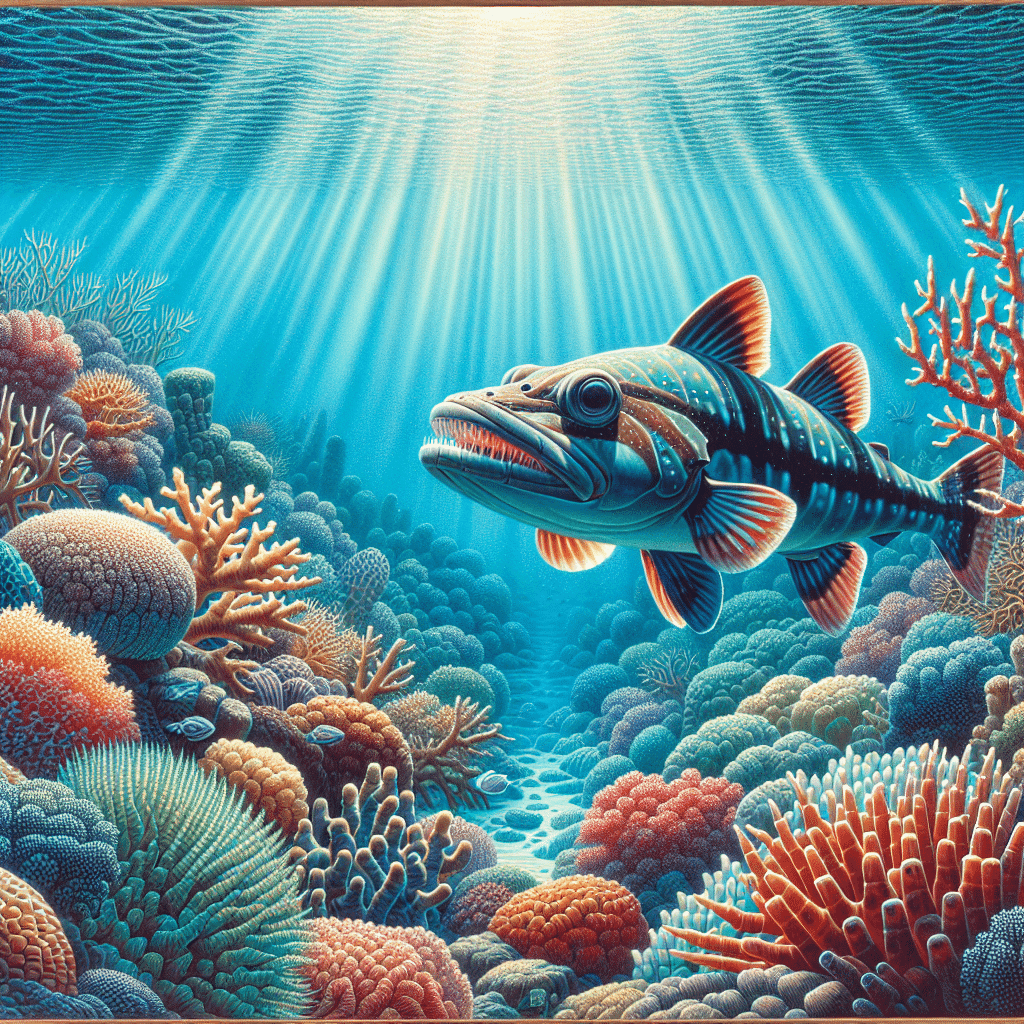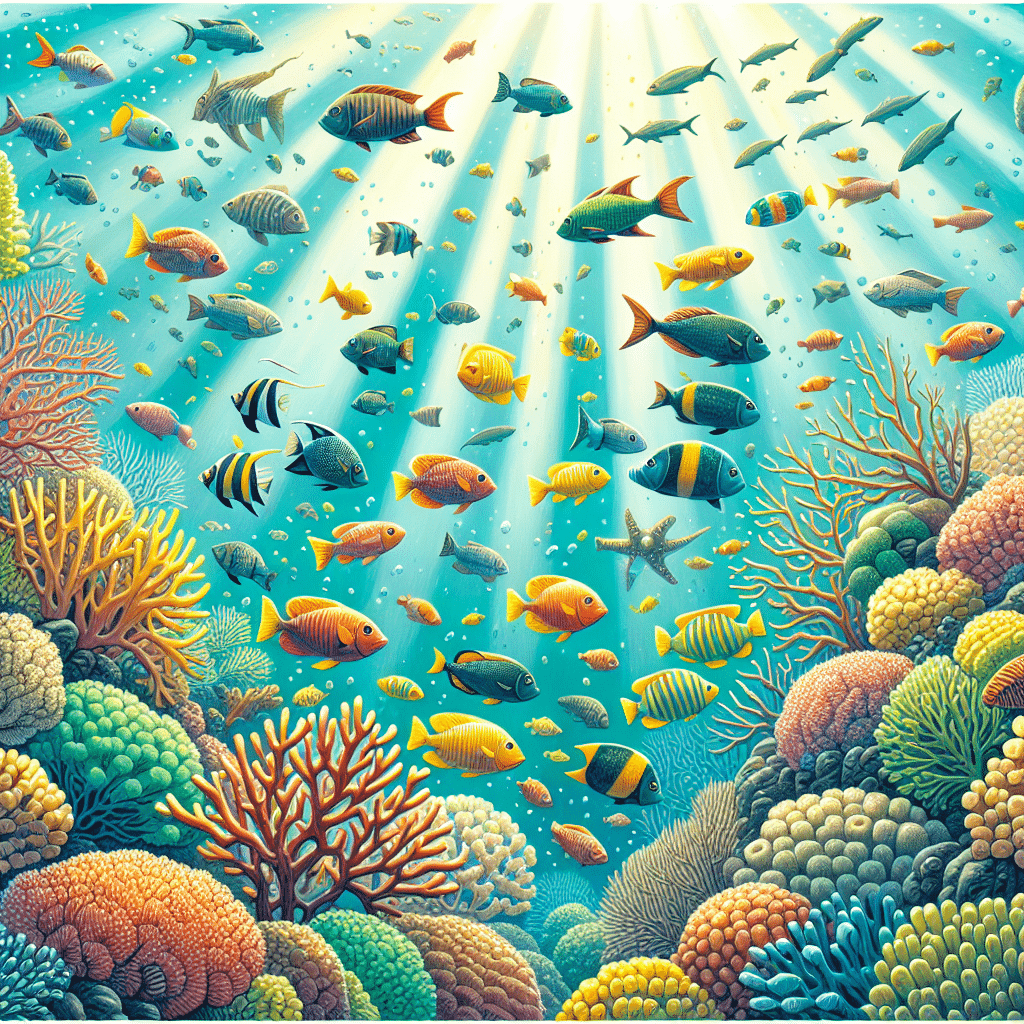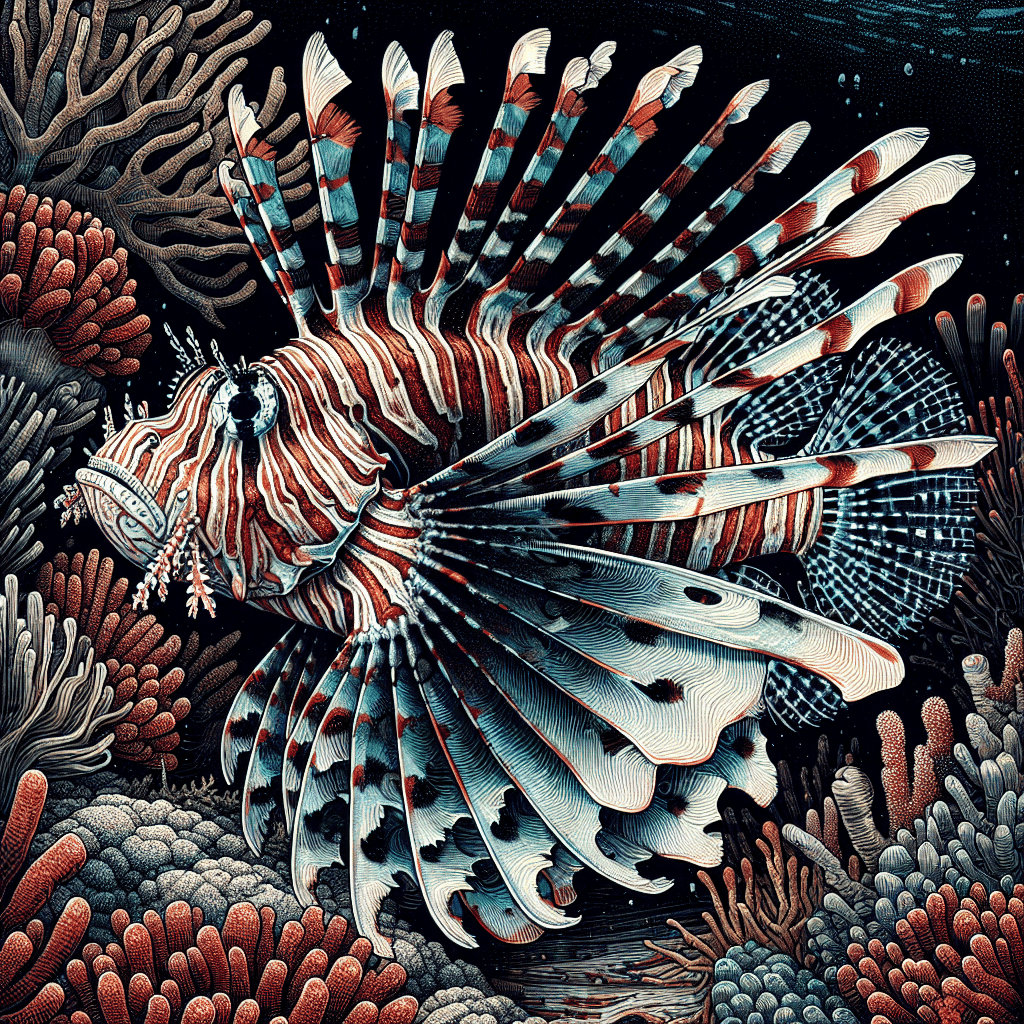Introduction to Jawfish
The Fascinating Yellowhead Jawfish
I’ve always been captivated by the vibrant and unique world of jawfish, particularly the yellowhead jawfish (Opistognathus aurifrons). This small but intriguing species can be found in the Caribbean Sea, specifically thriving in coral reefs at depths ranging from 3 to 40 meters (9.8 to 131.2 ft). They typically grow up to 10 centimeters (3.9 inches) in length, making them a manageable addition to many reef tanks.
What truly amazes me about the yellowhead jawfish is its fascinating breeding behavior. This species is known as a paternal mouthbrooder, meaning that the male fertilizes the eggs and carries them in his mouth until they hatch. During this nurturing process, he even takes breaks to spit the eggs back into his burrow for rotation and oxygen access (ScienceABC).
Yellowhead jawfish are social creatures and can be found living in groups of up to 70 individuals, often in rubble areas and sandy substrates. They are particularly common in Florida, where their lively antics can be observed in their natural habitat (Wikipedia).
In terms of behavior, the yellowhead jawfish exhibits interesting responses to threats. Depending on the type of intruder, they may choose to flee or stand their ground. This adaptability is one of the many traits that make them fascinating to observe.
For those considering adding jawfish to their aquarium, they are relatively docile towards their own species and can be kept in small groups, ideally one fish per 10 gallons of water. They thrive on a diet of planktonic matter, including brine shrimp, mysis shrimp, and high-quality prepared frozen or pelleted fish food (Wikipedia).
These traits make yellowhead jawfish not just an attractive choice for reef tank hobbyists but also a rewarding one, as their behaviors and interactions can be quite engaging. If you’re looking to learn more about marine fish to populate your aquarium, check out our articles on various species like clownfish, goby, or even lionfish.
Habitat and Behavior
Natural Habitat of Jawfish
The yellowhead jawfish (Opistognathus aurifrons) is a fascinating species that I find particularly interesting. It thrives in the Caribbean Sea, where it inhabits coral reefs at depths ranging from 3 to 40 meters (9.8 to 131.2 ft) (Wikipedia). These little guys can grow up to 10 centimeters (3.9 inches) in length and are commonly spotted in places like Florida.
Jawfish tend to live in groups of up to 70 individuals, often found in rubble areas and sand. Their natural environment is crucial for their well-being, as they depend on the structure provided by coral and other materials to create their burrows. An ideal sandbed for a jawfish should be at least 10 to 12 inches deep, with 6 inches being the absolute minimum. Fine grain sand is recommended, but be prepared for the jawfish to clear away a large area on the first night as they establish their home.
Unique Behaviors of Jawfish
One of the most remarkable aspects of jawfish behavior is their unique responses to intruders. Depending on the type of incoming fish, they can either flee or fight. When they sense danger, they will swim away and retreat into their burrow, covering the entrance with a large rock. This behavior is a fascinating survival tactic that showcases their adaptability. On the other hand, if they choose to confront the intruder, they spit sand or small rocks at it as a defense mechanism (Wikipedia).
Another interesting behavior is their nesting habits. Jawfish are mouth brooders, meaning they create dens using their mouths. These dens can be quite spacious, ranging from 4 to 9 inches deep, nearly 9 inches wide, and about 2.5 inches tall. They construct these homes from broken coral branches, pieces of coral limestone, bivalve and snail shells, and various hard materials. Their diet primarily consists of zooplankton from the water column, which they expertly capture while hovering near their dens.
For those of us keeping jawfish in an aquarium, it’s crucial to understand their natural habitat and behaviors. This knowledge will help in providing a suitable environment that mimics their natural conditions and supports their well-being. Interested in learning more about other marine fish? Check out our guide on marine fish.
Care Guide for Jawfish
Caring for a jawfish can be a rewarding experience, especially if you’re looking to add some unique charm to your reef tank. Here’s what I’ve learned about their tank requirements and feeding habits.
Tank Size and Setup
To keep a jawfish, the first thing I consider is the tank size. A jawfish should be the first fish added to the aquarium because they can be difficult to acclimate once other fish are already established. I recommend a tank size of at least 20 gallons, especially if you plan on keeping more than one.
For the substrate, I ensure that the sandbed is at least 10 to 12 inches deep, with 6 inches being the absolute minimum. This depth is crucial since jawfish love to burrow. I prefer using fine grain sand, but I’m always ready for the jawfish to clear out a large area during their first night. They are quite the builders!
Here is a quick reference table for the ideal tank setup:
| Feature | Recommendation |
|---|---|
| Minimum Tank Size | 20 gallons |
| Minimum Sandbed Depth | 10 – 12 inches (6 inches minimum) |
| Substrate Type | Fine grain sand |
Feeding Jawfish
Feeding jawfish is relatively straightforward. In captivity, they thrive on a diet that includes planktonic matter such as brine shrimp, mysis shrimp, and prepared frozen and pelleted fish food. I make sure to offer a variety of foods to keep them healthy and happy.
Jawfish are generally docile towards their kind, so I can keep one individual per 10 gallons of water without any issues. It’s essential to provide enough food so they can forage and fill their bellies. I often feed them a couple of times a day, ensuring that I don’t overfeed.
Here’s a simple table summarizing their dietary preferences:
| Food Type | Examples |
|---|---|
| Live Food | Brine shrimp, mysis shrimp |
| Frozen Food | Prepared frozen fish food |
| Pelleted Food | High-quality fish pellets |
Providing the right tank environment and diet is key to keeping jawfish healthy. For more information on marine fish species that could coexist with jawfish, check out our detailed sections on various marine fish.
Compatibility with Tank Mates
When setting up a tank for jawfish, choosing the right companions is essential for maintaining a harmonious aquarium environment. In my experience, understanding what works well with jawfish can make all the difference.
Suitable Tank Mates for Jawfish
Jawfish are relatively social creatures and can coexist with several other species. However, it’s crucial to select tank mates that won’t stress them out or pose a threat. Some suitable companions include:
| Tank Mate | Compatibility Notes |
|---|---|
| Cardinalfish | Peaceful and small, ideal for jawfish. |
| Anthias | Active but non-aggressive. |
| Blennies | Small and generally peaceful. |
| Pipefish | Similar care needs and peaceful. |
| Dragonettes | Small and compatible. |
| Most Gobies | Generally non-aggressive. |
| Some Wrasses | Choose smaller, less aggressive types. |
I avoid larger or aggressive fish that might see jawfish as a snack. Keeping fast or active swimmers like surgeonfish, angelfish, and butterflies away is also a good idea. Natural predators such as groupers, lionfish, and certain wrasses can be particularly harmful to jawfish.
Avoiding Natural Predators
When I set up my tank, I make sure to avoid any fish that might prey on jawfish. They are particularly vulnerable to aggressive species. Here’s a quick list of fish to steer clear of:
| Fish Type | Reason for Avoidance |
|---|---|
| Groupers | Aggressive and predatory. |
| Lionfish | Venomous and predatory. |
| Certain Wrasses | Some can be aggressive towards jawfish. |
| Fast Swimming Fish | They may outcompete jawfish for food. |
Jawfish are quite timid and can easily get stressed. Their natural behavior includes retreating into burrows, and they can be startled easily. Providing a peaceful environment is key to ensuring they thrive.
By thoughtfully selecting tank mates and avoiding potential threats, I’ve seen my jawfish flourish in a lively, community aquarium. For more on compatible marine species, check out our section on marine fish.
Captive Environment
Creating a suitable captive environment for jawfish is crucial for their health and happiness. I’ve found that understanding their acclimation needs and setting up the tank properly makes all the difference.
Acclimation Tips for Jawfish
When introducing jawfish into my aquarium, I always make sure they are the first fish added. They are quite sensitive and can struggle to acclimate once other fish are already established. Here are some steps I take for a smooth acclimation process:
- Drip Acclimation: I use the drip acclimation method, which involves slowly introducing the jawfish to the tank water over several hours. This helps them adjust to the new water parameters.
- Monitor Behavior: After adding the jawfish, I watch their behavior closely. They are diurnal and will start to construct their den once the lights go out, so I make sure not to disturb them during this time.
- Provide Hiding Spots: I ensure that there are plenty of hiding spots and structures for them to feel secure while they adjust.
Creating an Ideal Tank Environment
Setting up the perfect environment for jawfish involves a few specific considerations:
- Tank Size: A minimum tank size of 30 gallons is recommended to provide enough space for swimming and burrowing.
- Substrate: I always use a sandbed that is at least 10 – 12 inches deep, with 6 inches being the absolute minimum. Fine grain sand is best, but I prepare for jawfish to clear a large area on the first night as they start to dig (Reefkeeping Magazine).
| Aspect | Recommendation |
|---|---|
| Minimum Tank Size | 30 gallons |
| Sandbed Depth | 10 – 12 inches (minimum 6 inches) |
| Substrate Type | Fine grain sand |
- Dens and Burrows: Jawfish love to burrow. I create a setup with various size rocks among the soft substrate to reinforce their burrows. Rockpiles are ideal, as they can use these to create their homes.
- Tank Lid: Since jawfish like to jump when startled, I ensure the tank has a tight-fitting lid. This is crucial for preventing any escape attempts.
By following these guidelines, I can help ensure that my jawfish thrive in their new environment. Providing the right conditions not only keeps them healthy but also allows me to enjoy their fascinating behaviors as they settle into their new home. If you’re looking to learn more about compatible tank mates, check out my article on marine fish.
Fun Facts about Jawfish
Playful Nature of Jawfish
I’ve always found jawfish to be some of the most entertaining fish in the aquarium. The Yellowhead Jawfish, in particular, has a truly charming personality. They are playful and enjoy people-watching, which makes them a delight to observe. These fish are moderately hardy but tend to be shy, thriving best in the company of other docile species. They won’t cause trouble for other tank inhabitants, but it’s wise to keep them away from more aggressive or burrowing fish that might bully them.
One of the fun aspects of keeping jawfish is watching their unique behavior. They spend a lot of time in their burrows, where they feel safe and secure. If startled, they can quickly dart back into their burrow tail-first, showcasing their incredible speed. If you’re interested in adding some personality to your tank, jawfish are definitely worth considering.
Burrowing and Jumping Behavior
Jawfish are known for their remarkable burrowing abilities. They need a substrate depth of about 5-7 inches of fine sand to create their burrows effectively. Providing various sizes of rocks among the soft substrate can help reinforce these burrows, making them more stable and secure. Watching them dig and rearrange the sand is quite a sight.
What’s more, these little fish can be quite the jumpers! When startled, they can leap out of the water, so it’s crucial to have a tight-fitting lid on the tank. I’ve learned this the hard way, so trust me, it’s better to be safe than sorry. If you have multiple jawfish in a tank, you’ll be treated to a fascinating display as they “dance” up and down in their burrows, creating a lively and dynamic environment.
If you’re keen on keeping jawfish, remember to create an ideal setup that allows them to showcase their burrowing and jumping antics. A well-thought-out aquarium can provide endless entertainment for you and a perfect habitat for them.
Yellowhead Jawfish Specifics
Characteristics of Yellowhead Jawfish
The yellowhead jawfish, scientifically known as Opistognathus aurifrons, is a captivating fish that thrives in the Caribbean Sea. I find these little guys fascinating because they have some unique traits. They typically grow to about 10 centimeters (3.9 inches) in length and can be found in coral reefs at depths ranging from 3 to 40 meters (9.8 to 131.2 feet) (Wikipedia).
One of the most interesting characteristics of the yellowhead jawfish is its social behavior. These fish often live in groups of up to 70 individuals in sandy and rubble areas. They are also mouthbrooders, meaning the male carries the eggs in its mouth until they hatch. When it comes to defending their territory, they can either flee or confront intruders, depending on the situation.
| Characteristic | Detail |
|---|---|
| Scientific Name | Opistognathus aurifrons |
| Maximum Length | 10 cm (3.9 in) |
| Natural Habitat | Coral reefs in the Caribbean Sea |
| Depth Range | 3 to 40 meters (9.8 to 131.2 ft) |
| Social Structure | Groups of up to 70 individuals |
Keeping Yellowhead Jawfish in the Aquarium
When I consider adding yellowhead jawfish to my aquarium, I keep a few key points in mind to ensure they thrive. First, it’s important to maintain a suitable environment. These fish prefer sandy substrates where they can create burrows. I usually aim for a tank size of at least 10 gallons for one yellowhead jawfish, as they can be kept in small groups of one individual per 10 gallons.
In terms of feeding, yellowhead jawfish are not picky eaters. They thrive on a diet of planktonic matter, including brine shrimp, mysis shrimp, and high-quality prepared frozen or pelleted fish food (Wikipedia).
It’s also crucial to monitor the tank’s water parameters. They prefer stable conditions with a temperature between 24°C to 28°C (75°F to 82°F) and a pH level between 8.1 and 8.4. Regular water changes help maintain a healthy environment for these charming fish.
| Care Aspect | Recommendation |
|---|---|
| Tank Size | Minimum 10 gallons per fish |
| Substrate | Fine sand for burrowing |
| Temperature | 24°C to 28°C (75°F to 82°F) |
| pH Level | 8.1 to 8.4 |
| Diet | Brine shrimp, mysis shrimp, and high-quality prepared foods |
By understanding the specifics of yellowhead jawfish and providing the right care, I can create a thriving environment for these unique reef inhabitants in my aquarium. For additional information on other marine fish, check out our article on marine fish.
Feeding Yellowhead Jawfish
Feeding my yellowhead jawfish has been an interesting experience, and understanding their dietary preferences is key to keeping them healthy and thriving in my reef tank.
Dietary Preferences of Yellowhead Jawfish
Yellowhead jawfish primarily feed on planktonic matter in their natural habitat. In captivity, they enjoy a diet that includes live and frozen foods. Some of their favorites are:
- Brine shrimp
- Mysis shrimp
- Prepared frozen fish food
- Pelleted fish food
These foods are rich in the nutrients they need to stay healthy and active. Since they are mouth brooders, the male jawfish also needs to maintain a good diet to ensure the health of the eggs he carries (ScienceABC). It’s important to offer a varied diet to keep them engaged and well-nourished.
| Food Type | Description |
|---|---|
| Brine Shrimp | Live or frozen, great for protein |
| Mysis Shrimp | Nutritious and appealing to jawfish |
| Frozen Fish Food | Convenient and easy to store |
| Pelleted Fish Food | Balanced nutrition for daily feeding |
Feeding Tips for Yellowhead Jawfish
When it comes to feeding my yellowhead jawfish, there are a few tips I’ve picked up along the way that help ensure they get the nutrition they need:
Feed Small Portions: Since jawfish have small mouths, it’s best to feed them small portions multiple times a day rather than one large meal. This mimics their natural foraging behavior.
Use a Feeding Stick: I like to use a feeding stick or tongs to place the food near their burrow. This way, they can easily grab it without needing to swim too far from their home.
Observe Their Behavior: Watching how they respond to food can help me determine if they are getting enough nutrition. If they seem uninterested, I might try different types of food.
Avoid Overfeeding: It’s easy to overfeed jawfish, which can lead to water quality issues in the tank. I make sure to remove any uneaten food within a few minutes.
Supplement Their Diet: Occasionally, I provide supplements like spirulina or other marine-based vitamins to enhance their diet. This helps in maintaining their overall health and vibrancy.
For more information on keeping jawfish and other marine fish, check out our article on marine fish.



